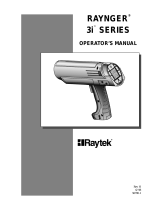Page is loading ...

ATE-2520
INFRARED THERMOMETE
USER’S MANUAL
CONTENTS
1. Safety information………………………………………….1
2. Cautions…………………………………………………….1
3. Names of components…………………………………….2
4. LCD illustration……………………………………………..3
5. Measurement principle…………………………………….4
6. Operating instruction……………………………………….4
7. D:S ratio……………………………………………………...5
8. Emissivity…………………………………………………….6
9. Changing the battery………………………...……………..7
10. Specifications………………………………………………8

ATE-2520
1. SAFETY INFORMATION
* Please read the following information carefully before
using the meter.
* Do not clear the meter using solvents.
Safety symbols:
Important safety information, refer to the
operating manual.
Comply with European CE safety standards
This instrument is compatible with the following standards:
* EN61326-1
* EN61010-1
* EN60825-1
Warning: Do not point laser directly at eye or
indirectly off reflective surfaces.
2. CAUTIONS
When ambient temperature changes quickly, it must wait 30
minutes to balance the heat of the instrument before use.
Avoid EMF (electromagnetic fields) from arc weld,
induction furnace, etc…
Do not leave the unit on or near high temperature objects.
Keep the instrument clean, and do not get dust into
detecting hole.
3. NAMES OF COMPONENTS
1. Trigger
2. Battery cover
3. LCD display
4. Back light button
5. Ambient temperature button
6. Mode button
7. °C/°F selection button
8. Laser button
- 1 - - 2 -

ATE-2520
9. Collimator
10. Temperature detect hole
11. Laser emission orifice
4. LCD illustration
1. Measurement indication
2. Data hold
3. The first temperature display
4. Average value indication
5. Max/Min/Max-Min value indication
6. Ambient temperature measurement indication
7. Emissivity display
8. Back light indication
9. Laser emission indication
10. Low power indication
11. °C temperature unit
12. °F temperature unit
13. The second temperature display
5. MEASUREMENT PRINCIPLE
Non-contact Thermometer detects the infrared ray that an
object emits, The instrument focalizes infrared energy of the
object onto a sensor through a lens, changes the surface
temperature into electric signal, a microcomputer calculates
and displays the measurement temperature on the LCD.
The method can measure object’s surface temperature
without contact. The laser is used to aim target only.
6. OPERATING INSTRUCTION
1. To measure the temperature of an object, point the unit at
it, press the trigger down and keep, you can measure the
temperature continuously. After releasing trigger, LCD will
hold the result of measurement. The first temperature
indicates the current measurement value; the second
temperature indicates the calculated value.
- 3 -
- 4 -

ATE-2520
2. When an object is far from the thermometer, by pressing
laser button to light the laser to aim at object.
3. To measure in the night, by pressing backlight button to
light the backlight.
4. By pressing “MODE” button to change the mode of the
second temperature, it can show AVG (average), MAX
(maximum), MIN (minimum), MAX-MIN value.
5. By pressing °C/°F button to choose °C or °F temperature
unit to show temperature.
6. To measure the ambient temperature, just press “Tamb”
key, and then press the trigger down and keep, you can
get the measurement result from LCD directly. After
releasing trigger, LCD will hold the measurement result.
The first value indicates the temperature of an object;
the second value indicates the ambient temperature.
NOTE:
(1) To get an accurate measurement result, refer to D:S
ratio, Emissivity sections.
(2) After releasing the trigger, the unit automatically turns off
after about 25 seconds of inactivity.
7. D:S RATIO
The thermometer has a visual angle and visual spot size; a
drawing shows it as following:
Object focus tube sensor
Make sure that the target is larger than the unit’s visual spot
size. The smaller the target, the closer you should be to it.
The relationship between distance and spot size is 8:1, the
drawing as following:
Distance (D) Spot size (S)
8. EMISSIVITY
Emissivity is used to describe the energy-emitting
characteristic of materials. The greater the emissivity, the
stronger the emission capacity of the object is. Most organic
materials and oxidized metal surfaces have an emissivity
- 5 - - 6 -

ATE-2520
between 0.85 to 0.98. The thermometer is designed
according to that emissivity equals 0.95. When the
Emissivity of an object is less than 0.95, the measurement
temperature is less than the actual temperature; and the
emissivity of an object is more than 0.95, the measurement
temperature is more than the fact temperature. A shiny
metal or a polished object surface has a low emissivity.
Please pay attention to the effect of emissivity of objects.
9. CHANGING THE BATTERY
When the battery voltage is lower, the battery symbol
appears; it indicates that we must change the battery. Pinch
OPEN characters on the battery cover, then pull it and can
change a new battery. See the drawing as the following:
10. SPECIFICATIONS
LCD display: Double temperature 4 digitals LCD
Field of view: 8:1
Emissivity: 0.95
Spectral response: 8 -14 um
Measure range: -50°C ~ 500°C (-58°F ~ 932°F)
Ambient temperature range: 0°C ~ 50°C
Accuracy: -50°C ~ -20°C: ± (5°C/9°F)
-20°C ~ 500°C ± (reading×1.5% + 2°C/4°F)
Response time: 0.5 second
Laser power: Less than 1 mw
Auto power off: 25 seconds
Backlight: White
Operation surrounding: 0~50°C, 10 ~ 90%RH
Storage surrounding: -10°C ~ 60°C, ≤75%RH
Battery: 9V (6F22)
Size: (Length) 120 × (Width) 45 × (high) 180mm
Weight: Approximately 205g (including battery)
Accessories: Battery 9V, operation manual, bag
- 7 -
- 8 -
/



